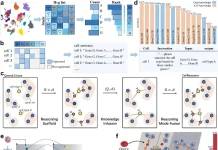A collaborative research effort led by scientists and engineers at the University of Pennsylvania and Northwestern University led to the development of FateMap, a framework that combines DNA barcoding, single-cell RNA sequencing (scRNA-seq), and computational analysis to study the ‘fate’ or outcomes after exposing cancer cells to therapeutic drugs. It has been found that even within a group of genetically similar cells, small subgroups of resistant cells emerge. FateMap helps identify resistant cells from subpopulations derived from single-cell (clonal) cancer populations and analyze their unique characteristics.
While studies have been performed on tracking molecular developments that take place within cells during drug treatment, the outcomes following treatment have yet to be extensively studied. Upon exposure to therapeutic drugs, resistant clones form resistant colonies and proliferate. Resistant clones have shown unexpected heterogeneity, but it is unclear whether these differences are inherent or if outside factors are to blame. Transcriptional and functional diversity have also been observed using FateMap, integrated with various other computational techniques. At the same time, it can determine the origin of the clone as well as its transcriptional profile. Interestingly, no genetic foundation for cell diversity was observed within resistant clones.
How does FateMap work?
There are three basic components involved:
- DNA Barcoding
This method is used for marking the target cells. This is achieved by incorporating lentivirus containing ‘barcodes’ into the DNA of cells before they undergo therapy. These barcodes are created using a collection of oligonucleotides, each consisting of 20 base pairs. A library of barcodes is created by flanking these nucleotides with fixed ‘anchor’ sequences; these enable the identification of the sequences containing barcodes and help filter out external non-barcode sequences. Central to this method are the unique entities known as “singletons”—individual cells distinctly marked with solitary barcodes. Through a strategic integration process, these barcoded cells are subjected to therapeutic drug treatments, with a specific focus on this study’s use of vemurafenib for targeted therapy. After treatment, resistant populations are screened and collected. The barcodes select clones from a group of resistant cells.
These barcoded cells are then treated with therapeutic drugs; in this study, vemurafenib was used for targeted therapy. After treatment, resistant populations are screened and collected. The barcodes select clones from a group of resistant cells.
- Single-cell RNA sequencing
Expression profiles for individual cells are then produced with scRNA-seq. The barcodes for clones obtained from the previously performed steps in FateMap are amplified and, subsequently, sequenced to produce a cDNA library. This library links cell identifiers and barcodes for clones. It is performed on a culture containing a mixture of all the resistant colonies, demonstrating a great extent of diversity within gene expression profiles. Multiple markers are similar to those of different cell types, such as smooth muscle, neural crest, melanocytic, and adhesive cells. Cell lines obtained from melanoma and breast cancer were used for this study.
- Computational Analysis
There are challenges in the identification of relevant clusters of cells where molecular differences can be observed. This issue can be resolved by using computational techniques such as ClonoCluster, which combines information about clones with transcriptional data. FateMap linked the clones with their respective clusters using this.
The ‘fate’ lying in store for cancer cells after treatment
On using FateMap to sieve out resistant clones from groups of cancer cells following treatment, various molecular and morphological variations were observed; some of the resistant cells were completely differentiated as well. This showed diversity among clonal populations of resistant cells. These variations were determined by molecular differences observed in the cells prior to and after the drug treatment. Switches in resistant types were also noticed with changing doses and types of drugs used. A general feature observed was that these differences were non-genetic; that is, they were present only in the intrinsic states of cells.
Cellular heterogeneity in the resistant clones was demonstrated using cell line profiling. Variation in clonal cell lines also exhibited clonal memory. These variations manifest into several cancer phenotypes, such as resistance to therapy, tumorigenicity, increased growth, and fatal metastasis, and are, therefore, a nuisance to therapy, preventing treatment. Among the several disparities present between resistant clones, two types were prevalent. The first type is ‘within’ clonal diversity; this implies resistant cells can switch between different types. The second type is ‘between’ clonal diversity; these resistant clones are transcriptionally stable.
Two major factors are believed to determine underlying cell types: the lasting memory of the starting state of the cells and the effect of intrinsic factors. The former is observed by studying twin clones of the same; these are intrinsically determined types of cells. The latter has been observed through analysis of differentiation in cardiac cells. There is a possibility of a type that has short memory and is intrinsically determined as well, but it is difficult to differentiate as minimal correlation is observed between the types of twins when conducting twin experiments. The outcome is determined by the twins’ condition before exposure to external factors.
Variations observed in resistant cells
FateMap split cells into low- and high-concentration dose environments, respectively, after barcoding. A greater degree of resistance has been shown at low concentrations within existing clones as well as additional clones. In the case of metronomic therapy, where drugs are administered at discontinuous intervals, a higher number of resistance cells and larger colonies were observed.
Fate switching was observed when markers of specific clusters, such as those of NGFR-high-resistant cells belonging to cluster 9, exhibited characteristics of other types of cells from other clusters, such as those of MLANA-high cells belonging to cluster 6. NGFR and MLANA, indicating neural crest cells and melanocytic cells, respectively, are biomarkers that are used to identify different cell types; here, intrinsic predetermination of resistant cell types is shown by barcode overlapping observed on performing pure barcode sequencing of genomic DNA (gDNA) of the clonal populations.
Changing the type of drug influences the presence of resistant cells as well. In treating MLANA-high-resistant cells with an alternate drug, trametinib, the elimination of clones was observed in the barcoding of the sequences. This outcome differed from the expected outcome of fate switching previously observed on treatment with vemurafenib.
Conclusion
Resistance clonal cells still remain mysterious, as it’s not yet determined how exactly these resistant types came about. It is currently hypothesized that there’s either a fixed regulatory program within the cells that leads to these predetermined outcomes or that the cells adapt to stress, leading to a variety of outcomes based on the type of stress and the specific internal state of the cell at a given time. Further studies in this domain can one day explain the molecular basis of this molecular reconfiguration. FateMap can lead us to discover the diversity of novel types of cells. It can be used in stem cell programming as well as directed differentiation.
Article Source: Reference Paper | Reference Article
Learn More:
Swasti is a scientific writing intern at CBIRT with a passion for research and development. She is pursuing BTech in Biotechnology from Vellore Institute of Technology, Vellore. Her interests deeply lie in exploring the rapidly growing and integrated sectors of bioinformatics, cancer informatics, and computational biology, with a special emphasis on cancer biology and immunological studies. She aims to introduce and invest the readers of her articles to the exciting developments bioinformatics has to offer in biological research today.
















